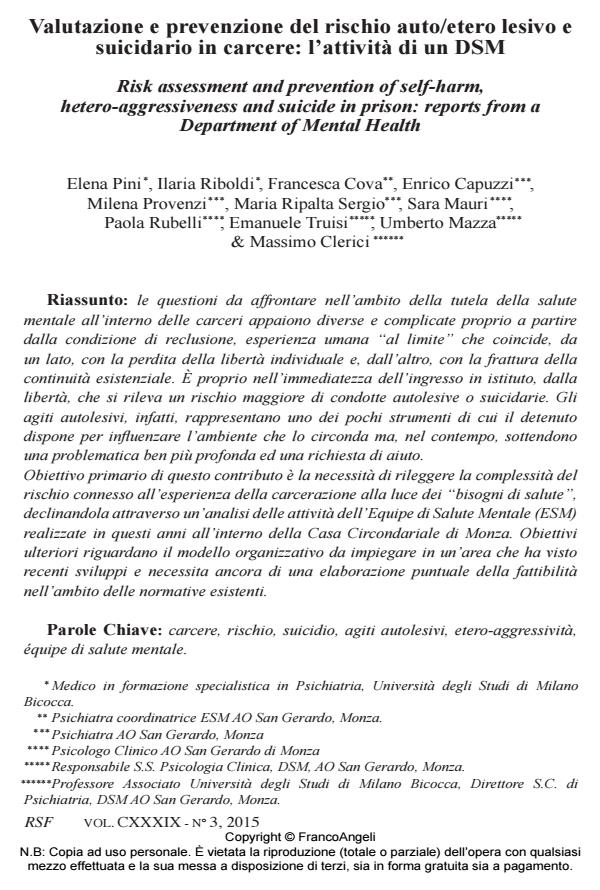Valutazione e prevenzione del rischio auto/etero lesivo e suicidario in carcere: l’attività di un DSM
Titolo Rivista RIVISTA SPERIMENTALE DI FRENIATRIA
Autori/Curatori Elena Pini, Ilaria Riboldi, Francesca Cova, Enrico Capuzzi, Milena Provenzi, Maria Ripalta Sergio, Sara Mauri, Paola Rubelli, Emanuele Truisi, Umberto Mazza, Massimo Clerici
Anno di pubblicazione 2015 Fascicolo 2015/3
Lingua Italiano Numero pagine 15 P. 147-161 Dimensione file 2268 KB
DOI 10.3280/RSF2015-003010
Il DOI è il codice a barre della proprietà intellettuale: per saperne di più
clicca qui
Qui sotto puoi vedere in anteprima la prima pagina di questo articolo.
Se questo articolo ti interessa, lo puoi acquistare (e scaricare in formato pdf) seguendo le facili indicazioni per acquistare il download credit. Acquista Download Credits per scaricare questo Articolo in formato PDF

FrancoAngeli è membro della Publishers International Linking Association, Inc (PILA)associazione indipendente e non profit per facilitare (attraverso i servizi tecnologici implementati da CrossRef.org) l’accesso degli studiosi ai contenuti digitali nelle pubblicazioni professionali e scientifiche
Le questioni da affrontare nell’ambito della tutela della salute mentale all’interno delle carceri appaiono diverse e complicate proprio a partire dalla condizione di reclusione, esperienza umana "al limite" che coincide, da un lato, con la perdita della libertà individuale e, dall’altro, con la frattura della continuità esistenziale. È proprio nell’immediatezza dell’ingresso in istituto, dalla libertà, che si rileva un rischio maggiore di condotte autolesive o suicidarie. Gli agiti autolesivi, infatti, rappresentano uno dei pochi strumenti di cui il detenuto dispone per influenzare l’ambiente che lo circonda ma, nel contempo, sottendono una problematica ben più profonda ed una richiesta di aiuto. Obiettivo primario di questo contributo è la necessità di rileggere la complessità del rischio connesso all’esperienza della carcerazione alla luce dei "bisogni di salute", declinandola attraverso un’analisi delle attività dell’Equipe di Salute Mentale (ESM) realizzate in questi anni all’interno della Casa Circondariale di Monza. Obiettivi ulteriori riguardano il modello organizzativo da impiegare in un’area che ha visto recenti sviluppi e necessita ancora di una elaborazione puntuale della fattibilità nell’ambito delle normative esistenti.
Parole chiave:Carcere, rischio, suicidio, agiti autolesivi, etero-aggressività, équipe di salute mentale
Elena Pini, Ilaria Riboldi, Francesca Cova, Enrico Capuzzi, Milena Provenzi, Maria Ripalta Sergio, Sara Mauri, Paola Rubelli, Emanuele Truisi, Umberto Mazza, Massimo Clerici, Valutazione e prevenzione del rischio auto/etero lesivo e suicidario in carcere: l’attività di un DSM in "RIVISTA SPERIMENTALE DI FRENIATRIA" 3/2015, pp 147-161, DOI: 10.3280/RSF2015-003010